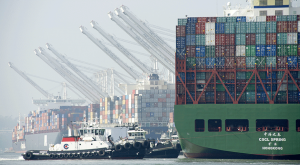
Activity at ports in California and elsewhere on the West Coast was brisk this week following the announcement last Friday of a tentative five-year agreement covering workers at all 29 West Coast ports.
In a joint statement, the presidents of the Pacific Maritime Association (PMA) and International Longshore and Warehouse Union (ILWU) gave credit to the U.S. Secretary of Labor and federal mediator for helping the parties achieve the deal, which still must be ratified. Details of the agreement have not been released.
Press reports cited pressure from elected officials and other interested parties as additional factors in the conclusion of the negotiations, which began last May and continued long after the previous contract expired in July 2014.
The White House called on both parties to “work together to clear out the backlogs and congestion in the West Coast ports” as the agreement is being finalized.
Trade experts predict it may take as long as three months before port operations return to normal.
Widespread Impact
Due to the wide-ranging impact of the slowdown in port activity in recent months, the California Chamber of Commerce and other business groups, including the U.S. Chamber of Commerce petitioned the White House to get involved last November.
In January, CalChamber was among 175 business groups that urged the heads of the PMA and ILWU to complete contract negotiations as quickly as possible to prevent further interruptions in the flow of commerce.
The groups represented a wide array of companies—manufacturers, farmers and agribusinesses, wholesalers, retailers, importers, exporters, distributors, and transportation and logistics providers.
With products stuck in ships at sea or in containers waiting to be unloaded on the docks, supply chain disruptions were reported in all industry sectors. Concerns about holiday season goods late last year gave way to worries about spring merchandise lines this year.
Manufacturers in the Midwest had to slow and even stop production lines due to delays in receiving critical inputs.
Jobs
The ILWU represents 20,000 West Coast full- and part-time dockworkers.
Port activity at ILWU marine terminals supported nearly 3.7 million California jobs in 2013, and contributed $742.8 billion to the state’s economy, about 37% of gross state product, according to a study prepared for PMA and released in April 2014.
About 70% of containerized cargo moves through ports in California, Oregon and Washington.
The Southern California ports of Los Angeles and Long Beach are the busiest and second busiest in the nation, while the Port of Oakland ranks as the third busiest.
Staff Contacts: Jeremy Merz, Susanne Stirling

